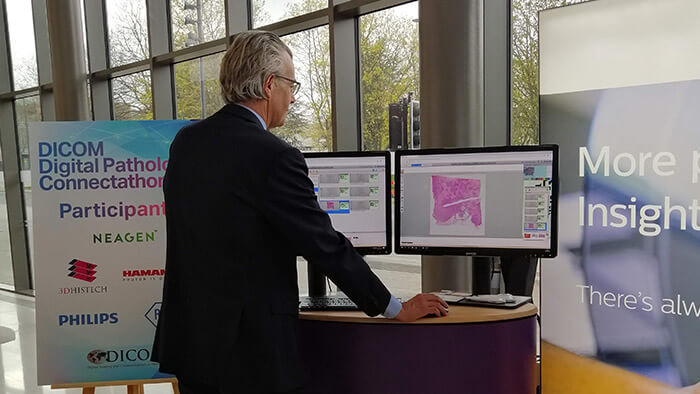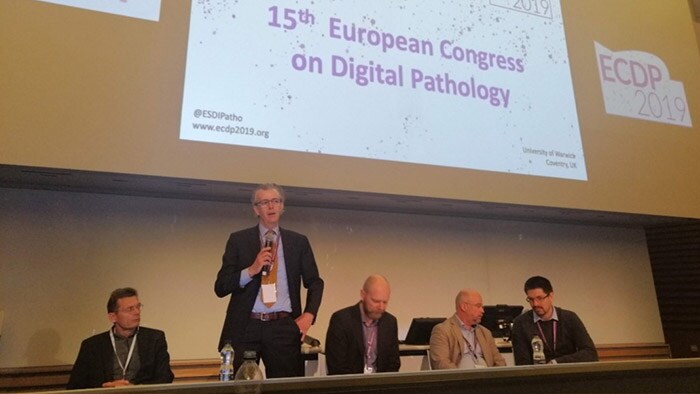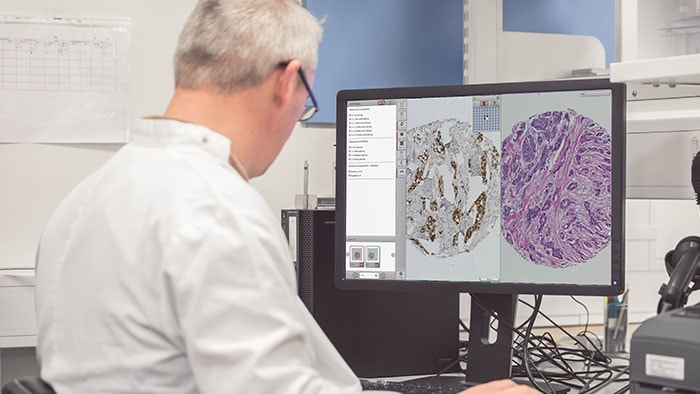The future of DICOM for digital pathology: An interview with Nick Haarselhorst
Share on social media
Overview of interview

Nick Haarselhorst, This blog helps to explain what a DICOM connectathon is and what the future could be for DICOM in digital pathology.
Interoperability Consultant and Expert at Philips Digital & Computational Pathology.
In this blog we would like to introduce Nick Haarselhorst, Interoperability Consultant and Expert at Philips Digital & Computational Pathology. Nick has participated in DICOM Connectathons on behalf of Philips such as the 2019 Pathology Visions Conference.

Please introduce yourself, Nick.
I am Nick Haarselhort and I have been working in the field of interoperability and DICOM standardization for 15 years and have been with Philips for 19 years. Since June 2015 I am part of the Digital & Computational Pathology business at Philips and I represent Philips at events like this.
What is a DICOM Connectathon?
A DICOM Connectathon is an event for proof of concept testing of the DICOM standards for pathology images also known as Whole Slide Images (WSIs). Participation in DICOM Connectathon is voluntary, and participants play distinct roles such as a standards compliant scanner or viewer or image archive. Vendors who participate typically select one or two roles and may use unreleased products to test newly developed capabilities.
Why is a DICOM Connectathon important for digital pathology?
DICOM Connectathons bring standards to life by bringing experts together to team up on realizing a practical working system that is interoperable based on industry accepted standards. One of the current challenges in digital pathology is the lack of standards for the entire workflow. This is very different from a mature medical healthcare modality such as radiology which has defined standards for years. Therefore, the DICOM Connectathon and DICOM Working Group 26 meetings help the digital pathology community drive towards standardization maturity for pathology use cases. In these meetings and Connectathon activities we verify the standards, test them, and create change proposals resulting from these practical exercises.
How does Philips participate? Tell me about what you did at the last DICOM Connectathon.
We are official members of the DICOM Working Group 26 dedicated to developing the DICOM-related standards for digital pathology. We participate every year in DICOM Connectathons, across the globe. We attended the PathVisions event in Orlando last year to play the role of the Acquisition Modality and to demonstrate our compliance to the available DICOM standard.

Why does Philips participate?
Philips is committed to actively participating in driving standardization in pathology and that is why we participate consistently in these events. We believe that standardized digital pathology will enhance patient care by making pathology data accessible to the clinical team across the entire healthcare enterprise. As an example, prostate cancer care teams carefully assess information from multiple disciplines such as pathology, radiology, surgery, and oncology. If all disciplines could employ standards and enterprise-wide solutions would be available to organize this data in a meaningful way, the oncology care team would be much more effective in treatment decision making due to seamless access to all the required patient information.
Is there a DICOM standard yet for pathology?
This is a tricky question as some standards for pathology exist but the entire workflow is not yet covered. An initial standard for the Whole Slide Image (WSI) format was drafted over 9 years ago and today after 3 years of testing with industry partners we recognize that the standard is maturing to a level where it could soon be used in clinical deployments. But an image format is not enough. For a complete workflow, further DICOM standards and standards beyond DICOM must be developed and implemented. DICOM provides the building blocks to realize some of this and we will continue to define new elements when aspects are missing, which is a continuous process in a new field like digital pathology. For example, Image Annotations and Analysis Results as part of AI, are future challenges which we will face. Another example is the growing need for standardization of Laboratory Information System metadata sharing which is also required for a successful standards based clinical workflow.
Is DICOM ready for digital pathology today?
For routine primary diagnostics, which involves replacing the microscope-based histopathology workflow with a digital pathology workflow, our view as Philips is that standards advancement is still required for DICOM to meet the demands of a 100% digital workflow. Philips has helped over 15 labs worldwide to go 100% digital and for us, performance, speed, and in-vitro diagnostic compliance are the most critical requirements. DICOM is just not fully ready for the scale and performance that clinical labs need based on our experience helping many labs adopt a 100% digital way of working.
When will DICOM be ready?
(smiles) Hard to say. In my opinion there will never be a final state, but we look forward to the moment when DICOM has matured sufficiently for implementation across the entire pathology workflow. One of the challenges is digital pathology is an evolving field which is not identical to radiology so new standards need to be developed. Another issue is regulatory concerns, for example some regulatory bodies do not yet recognize the current DICOM image format produced by scanner vendors as an IVD compliant image. Also DICOM, and other standards, will always need to be updated to enable the use of new developments such as computational pathology algorithms in the future. As Philips we are committed to the long game: getting a usable standard and following the evolution and advances to maintain the highest quality and interoperability in our clinical products.
What do enjoy the most about participating in DICOM Connectathons?
Our working group meets in person only a few times a year so it is nice to see vendors and participating pathologist colleagues in person and have an opportunity to work together to test our proposed technical solutions. It is exciting to see the proposed standards really work and it gives me a good feeling when I can demonstrate in front of end-users and real pathologists and hear their feedback. By giving them the right solutions to support their workflow, I can really contribute to our goal of improving the lives of patients.



